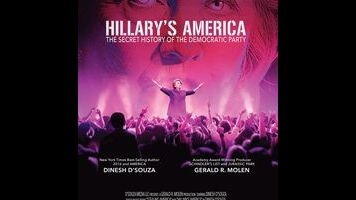Hillary’s America is a sort of double feature that picks up from there. Its first half is meant to make the case that the party of Lincoln is still the party of Lincoln and that Democrats are the true racists; its back half goes specifically after the presumptive Democratic candidate. The purely rhetorical argument that the “party of Lincoln” hasn’t wavered in character isn’t new; in 2013, continuing a newish post-federal election tradition, Rand Paul became the latest Republican to speak at Howard University to make that case to a crowd rightly skeptical of the idea that the GOP post-Nixon can claim legitimate continuity with its own past. Repetition of this facile argument is key, down to a speech given here by a pre-Civil War Republican: “We, the Republicans, are against slavery, and the Democrats are for slavery.”
The segments on slavery are vile, diving with no compunction into close-ups of black people being whipped and a selection of racist violence. These are still tough things to stage and watch, even when badly done; that Hillary’s America does so for no greater purpose other than, effectively, urging the election of Donald Trump speaks wretchedly of all involved. D’Souza undermines his putatively good intentions with a loud dog whistle when he repeatedly refers to slavery as “theft” and points out the story of one slave (owned by a Democrat, of course) punished for selling wares on the side. Entrepreneurial pluck, D’Souza is implying, was punished by Democrats from the get-go—they want to stop black folks from pulling themselves up by their bootstraps, and laziness has set in as a result. This is talking-points business as usual, in which any sign of a welfare state is in fact the manifestation of the “liberal plantation”—the real reason Democrats still enslave black voters, D’Souza says, and an argument he doesn’t bother to develop any further, its salience being already self-evident to target viewers.
Other images from D’Souza’s freewheeling parade through American history are comically grotesque, the sustained attack on Hillary Clinton a fever dream. A shot of Bill and spouse dancing and raising champagne flutes in the White House to celebrate some ghastly coup is entirely typical of D’Souza’s perspective: just shy of conspiracy theories about mysterious deaths and drug deals, but still safely in the realm of malignant fantasy. To reiterate the old canard that Margaret Sanger’s real mission was the extermination-via-abortion of black people, he stages her giving a speech on a porch deck, with a row of hooded KKK members sitting blithely before her. Sanger did indeed address the Klan—she’d speak with any organization receptive to learning about birth control—but it’s hardly a defining moment of her career; for D’Souza to stage this segment as a sinister extended tableau slides straight into a kind of Adult Swim absurdism, in which shots of an inadequate, orating Abraham Lincoln (Don Taylor) are assigned the same weight and importance in American history.
Taylor is a returning performer from America, a lanky void whose presence points to certain constants within the D’Souza Connected Universe: staggeringly unexciting talking-head interviews (give it up for the National Review’s Jonah Goldberg!); historical figures delivering long, oft-implausible harangues against cable-level backdrops; and—slightly less expected—musical numbers. In a presumable attempt to reclaim rock renditions of the National Anthem from the notedly unconservative Jimi Hendrix, America had an end credits rendition of “The Star Spangled Banner” from all-in conservative Dave Mustaine. Hillary’s America ends with no less than three songs: “God Bless America” (sung by Debbie, D’Souza’s new wife), the national anthem once again, and an end credits song from the Gatlin brothers, the former two accompanied by montages of stock “American” imagery in a limited historical pocket—brave Revolutionary soldiers bouncing on horses, fireworks, etc.
That a film already busy with historical reenactments, interviews, and conspiracizing of the wildest sort should end with three consecutive musical numbers suggests a kind of vaudeville structure to D’Souza’s work. As the MC of this show, D’Souza places himself in the unwise position of sometimes having to act: The film’s prologue finds him incarcerated in a detention house, where a charismatic inmate, Roc (Corey Cotten), explains for him how crime works, and how the government is the biggest criminal of all. D’Souza’s facial expression never varies from sour nonplussed; complex emotions aren’t a possibility. There is a shot in one of the final montages, amid all the farms and fields, of D’Souza standing in a sunset-lit prairie, looking like a Terrence Malick outtake. This determinedly uncharismatic figure has now made himself the star of three consistently lunatic productions; this attempt to give himself a moment of poetry is one of Hillary’s America’s final and biggest inadvertent laughs.









![HBO teases new Euphoria, Larry David, and much more in 2026 sizzle reel [Updated]](https://img.pastemagazine.com/wp-content/avuploads/2025/12/12100344/MixCollage-12-Dec-2025-09-56-AM-9137.jpg)































